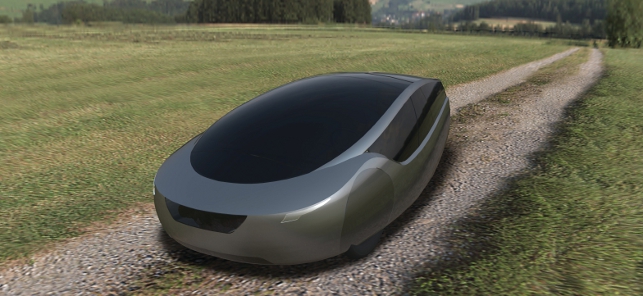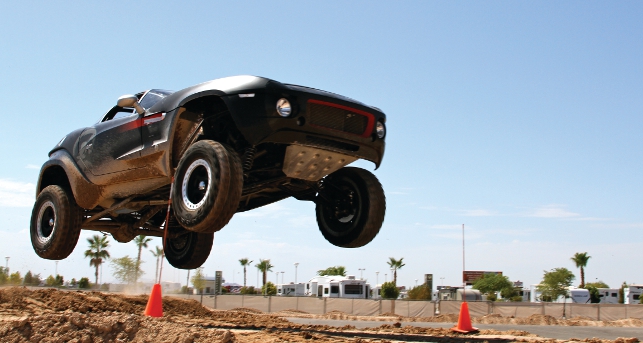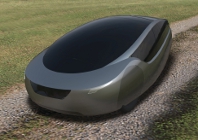Love the bug
No new car is developed without using modern technology, however, the Urbee has taken the revolutionary approach and pushed it even further.

Using tools already available and taking on a list of futuristic challenges, the Urbee has grown from the input of some extremely experienced designers and engineers.
Urbee (standing for urban electric with ethanol back up) is a low energy, practical, urban vehicle that can run on renewable energy, but what makes it more special is that it is the first full scale, fully operational 3D printed car.
Using Autodesk Inventor and Alias through the design process the team modelled the car, while also creating clay models of the shape. 3D laser scanning by Tebis was then used to get the clay-sculpted, 60 per cent scale model into the solids program for further CAD design.
These files were then sent to Stratasys, where its rapid prototyping capabilities allowed a 1/6 scale test model to be used to assess the fit up of body components.
Finally, full scale printed parts (also by Statasys) allowed the team to achieve Urbee’s extremely aerodynamic form, verify body fit with frame members, and achieve fabrication of the first prototype in a very short time scale.
From close up it’s hard to tell it has been printed, such is the detailed finishing and polishing, with a high gloss paint job.
As for the streamlined shape, CD-Adapco ran simulations to test Urbee’s overall aerodynamic performance, resulting in a coefficient of drag value for the overall car body of 0.15. This is a tiny amount for a two-person car.
Using rear wheel steering, it allows for a smaller frontal area, due to the compact, enclosed front wheels, resulting in further reducing drag and improving aerodynamics.
Its slim profile and printed panels have done little to stop it from passing all the needed crash tests, although it would be hard for other motorists not to slow down just to look at the unique Urbee as it tootles along.
Street fighting man
With curves in all the right places, this off-road, street legal car has both the grunt and the futuristic design process that will get everyone interested in Local Motors (LM).

The Rally Fighter is the first model from the Massachusetts-based firm that is determined to make the next great American car, using the advanced production methods and with collaborative design at its heart.
Using a method described as ‘co-creation’, it works in a way completely different to other automotive companies, allowing the designers to uncover better ideas faster with new and interesting material and powertrain ideas as soon as they are available.
LM has an underlying commitment to sustainable design. Its ‘Built Locally’ process allows it to leverage local vendors: reducing the wasteful process of shipping all its finished cars when instead it can ship the parts that are smaller and allow the car to drive away on its own power.
The car’s EROD engine is essentially a modern 6.2 litre, V8 Corvette engine. By UK standards that is a monster, however in comparison to most US muscle cars, it is as clean as a daisy – offering advanced emissions control with full catalytic converters, onboard vapour recovery, and modern fuel mapping to increase economy and to decrease emissions.
The original design is by Sangho Kim, a 2010 graduate of Art Center College of Design in Pasadena, California, who sketched the original concept work in 2008. However, by leveraging crowdsourcing for collaborative design a community of 13,000 had input in the entire process.
The vast swathe of designs will be brought down to a single product and designed and developed in Siemens’ Solid Edge software, with a special LM community version of the software available as Design1.
By being open source all chassis and body vehicle data is shared making the car building and modelling experience more enjoyable and accessible with the LM factory taking advantage of the rapid pace of design from the Co-Creation process.
It reduces waste and increases the time to market by only ordering and building what is necessary.
Under the radar
Any car with a bona fide ‘Stealth Mode’ is always going to grab our attention, but this goes deeper than a black paint job, relying on an innovative electric engine.

The Karma, is California-based Fisker’s first model: an eco-conscious car, with the ability to toggle between an all-electric, whispery quiet ‘Stealth Mode’ or fuel assisted, typically bellowing ‘Sport Mode’ with the simple shift of a paddle by the steering wheel.
Its Captain Planet credentials don’t stop with the power plant (incidentally, it’s a 2.0 litre 260 HP 4-cylinder direct injection petrol engine, with 981 lb/ft of torque instantly available at 0RPM), the solar glass roof is the largest ever designed for a production vehicle, giving you 200 miles travel for free each year; F1-style regenerative breaking technology; a water-based paint containing a recycled glass flake mixture for shine; and an interior trim made from reclaimed wood.
Earlier this year Fisker founder Henrik Fisker boasted: “We are combining our innovative technology and dedication to uncompromised design and performance to help re-invent the United States automobile industry by giving consumers around the world a new American car option that is bold, beautiful, smart, and environmentally friendly.”
On first impressions, and without jumping behind the wheel of one, we find it hard to disagree.
Fisker’s design team worked with Catia enabling the company to work from a single architecture for everything; from wire harness design to Class A surfacing, while PLM system, Enovia, manages the design data across multiple global locations.
“Catia’s functionality in both solid and surface modelling has enabled Fisker to develop a more efficient product development process where all design elements are integrated through one model, eliminating non-value added math conversion time,” explained Fisker’s director of operations Paul Houghton.
“This allows us to focus more on creativity so that we can deliver vehicles with unique styling in shorter time frames.”
So, finally petrol heads can drive an electric vehicle without feeling compromised on speed and performance.
Green and sustainable motoring without compromise
Default






